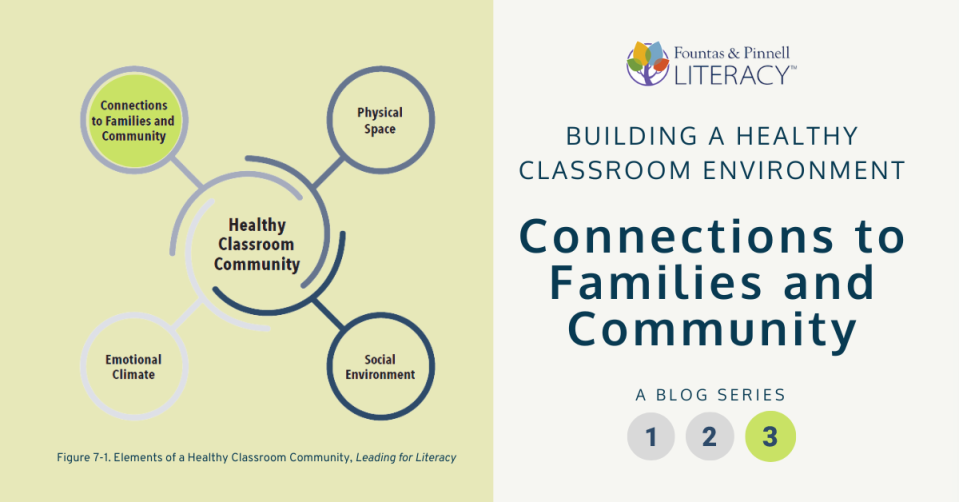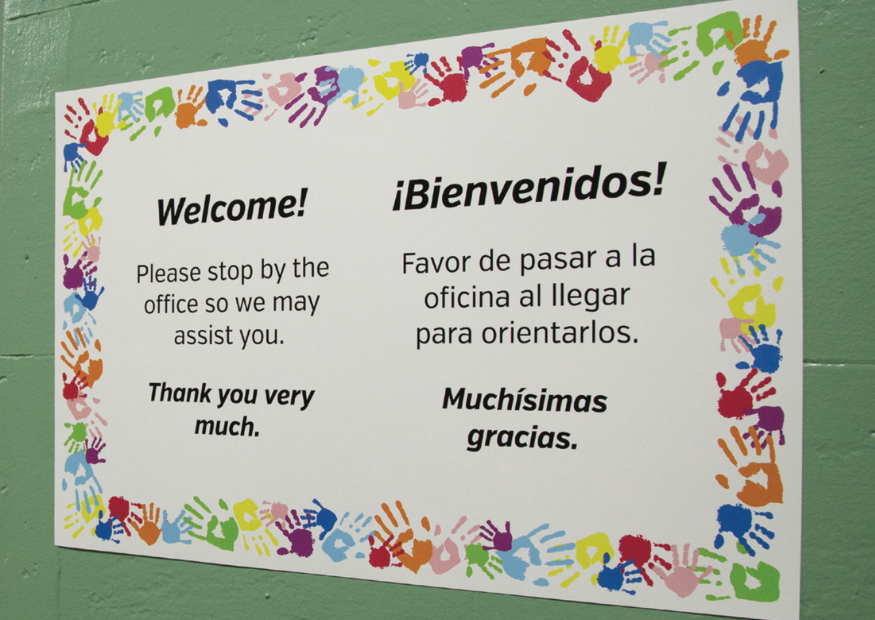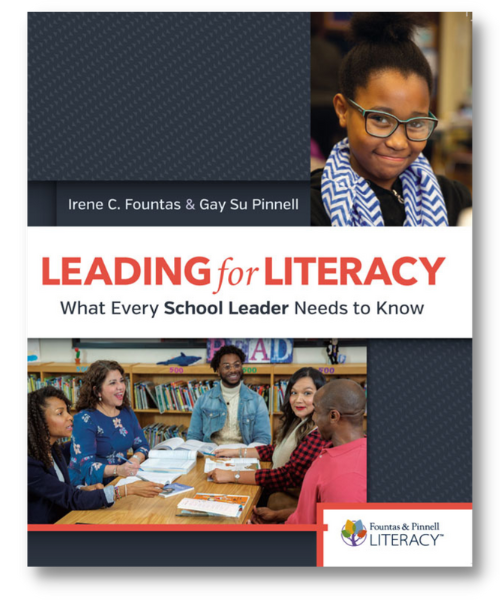
When you think about the resources that are available to you for improving student engagement in their classroom community, what comes to mind? If building connections with family and community has not been at the top of your list, this school year is an opportunity to think about how caregivers and community partners can help you make each child’s experience in your classroom more relevant, coherent, and connected to life outside of school. Actively nurturing family and community partnerships can be a powerful force in building and maintaining a healthy community of learners.
Honor the expertise of caregivers. Caregivers are knowledgeable, helpful partners who can support and sustain a child’s literacy success. Family members can contribute important information about their children, from interests and habits to strengths and areas of struggle. They can offer a wealth of information about their children that you can tap into to build relationships with your students and create culturally relevant learning experiences for everyone in your classroom.  Build trusting relationships with caregivers. Approach families as teammates with a shared goal—the growth and development of their child as a student and human being. As you listen to caregivers, spend time learning about what matters to them. Take time to learn about their cultures and their understandings and expectations of school. Share yours. Address caregivers’ practical concerns as well, like access to materials and technology in the home, work schedules, and preferences for communicating (e.g., phone, written notes, email, text, etc.). If there is a language barrier, talk to your principal or community partners about getting the support you need to work together.
Build trusting relationships with caregivers. Approach families as teammates with a shared goal—the growth and development of their child as a student and human being. As you listen to caregivers, spend time learning about what matters to them. Take time to learn about their cultures and their understandings and expectations of school. Share yours. Address caregivers’ practical concerns as well, like access to materials and technology in the home, work schedules, and preferences for communicating (e.g., phone, written notes, email, text, etc.). If there is a language barrier, talk to your principal or community partners about getting the support you need to work together.
Create a welcoming and inclusive culture in your classroom. Students and caregivers will feel welcomed and included when they recognize themselves and their classmates in the images, names, books, and writings on the wall of the classroom. Be mindful of incorporating students' home languages and cultures in ways that are visible. It is important that every student and family feel like equally valued members of the community.  Invite families into the classroom and send the classroom home. Think about creating opportunities for caregivers to spend time in your classroom. Share dates for special events well in advance. Create opportunities for caregivers to volunteer and contribute in any way they can. Find ways to send the classroom home with students, too. While newsletters and class websites are wonderful, emailing a personal video of a student reading or sharing their writing can make all the difference to a busy parent.
Invite families into the classroom and send the classroom home. Think about creating opportunities for caregivers to spend time in your classroom. Share dates for special events well in advance. Create opportunities for caregivers to volunteer and contribute in any way they can. Find ways to send the classroom home with students, too. While newsletters and class websites are wonderful, emailing a personal video of a student reading or sharing their writing can make all the difference to a busy parent.
Consider this:
When you think about the resources that are available to you for improving student engagement in their classroom community, what comes to mind? If building connections with family and community has not been at the top of your list, this school year is an opportunity to think about how caregivers and community partners can help you make each child’s experience in your classroom more relevant, coherent, and connected to life outside of school. Actively nurturing family and community partnerships can be a powerful force in building and maintaining a healthy community of learners.
Honor the expertise of caregivers. Caregivers are knowledgeable, helpful partners who can support and sustain a child’s literacy success. Family members can contribute important information about their children, from interests and habits to strengths and areas of struggle. They can offer a wealth of information about their children that you can tap into to build relationships with your students and create culturally relevant learning experiences for everyone in your classroom.  Build trusting relationships with caregivers. Approach families as teammates with a shared goal—the growth and development of their child as a student and human being. As you listen to caregivers, spend time learning about what matters to them. Take time to learn about their cultures and their understandings and expectations of school. Share yours. Address caregivers’ practical concerns as well, like access to materials and technology in the home, work schedules, and preferences for communicating (e.g., phone, written notes, email, text, etc.). If there is a language barrier, talk to your principal or community partners about getting the support you need to work together.
Build trusting relationships with caregivers. Approach families as teammates with a shared goal—the growth and development of their child as a student and human being. As you listen to caregivers, spend time learning about what matters to them. Take time to learn about their cultures and their understandings and expectations of school. Share yours. Address caregivers’ practical concerns as well, like access to materials and technology in the home, work schedules, and preferences for communicating (e.g., phone, written notes, email, text, etc.). If there is a language barrier, talk to your principal or community partners about getting the support you need to work together.
Create a welcoming and inclusive culture in your classroom. Students and caregivers will feel welcomed and included when they recognize themselves and their classmates in the images, names, books, and writings on the wall of the classroom. Be mindful of incorporating students' home languages and cultures in ways that are visible. It is important that every student and family feel like equally valued members of the community.  Invite families into the classroom and send the classroom home. Think about creating opportunities for caregivers to spend time in your classroom. Share dates for special events well in advance. Create opportunities for caregivers to volunteer and contribute in any way they can. Find ways to send the classroom home with students, too. While newsletters and class websites are wonderful, emailing a personal video of a student reading or sharing their writing can make all the difference to a busy parent.
Invite families into the classroom and send the classroom home. Think about creating opportunities for caregivers to spend time in your classroom. Share dates for special events well in advance. Create opportunities for caregivers to volunteer and contribute in any way they can. Find ways to send the classroom home with students, too. While newsletters and class websites are wonderful, emailing a personal video of a student reading or sharing their writing can make all the difference to a busy parent.
Consider this:
-
What is your plan for reaching out to families at the beginning of the school year to build relationships and gather valuable information about students? Will you send out a survey, make phone calls, schedule introductory conferences, or make home visits? How will you get the support you need to connect with all caregivers, even if you do not speak the same language?
-
How will you open the lines of communication in a manageable way so that parents know you welcome their input all year long?
-
Building trust takes time and persistence. If families don’t respond to outreach efforts, don’t assume that they don’t care. Keep trying!
When you include families as knowledgeable, valued partners in their children’s education, everyone benefits. With your support, the family of every child can participate in your classroom community in ways that honor their diverse cultures, experiences, identities, and their important contributions to their child’s learning. Building the home-school connection is a key to creating a healthy classroom community where all students can thrive.
• • •
Want to learn more and be part of the conversation? Join the Fountas & Pinnell Literacy™ Educator Community on Facebook where Fountas & Pinnell Literacy™ (FPL) educators can collaborate, learn, reflect, and discuss pedagogy and classroom implementation alongside peers and FPL consultants.
This blog is #3 in the 3-part Create a Healthy Classroom series and was adapted from Leading for Literacy: What Every School Leader Needs to Know by Irene Fountas and Gay Su Pinnell. Click the links below to read the other blogs in the series:
1. Create a Healthy Classroom Community: The Physical Setting
2. Create a Healthy Classroom Community: A Climate of Belonging
3. Create a Healthy Classroom Community: The Home-School Connection

Leading for Literacy provides guidance for creating a culture of collaborative professionalism, facilitating conversations about effective practice, and making high-impact decisions based on evidence and the values identified by the school team. An important resource for every school leader aiming to scale up excellence, Leading for Literacy helps leaders create effective systems for improving the literacy outcomes of all students.



